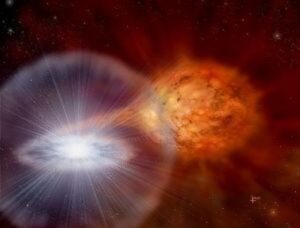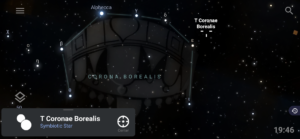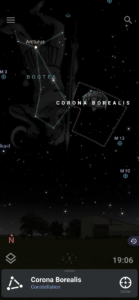An Exploding Star

Thats right we have a star in our sky set to explode (well technically it goes Nova) this is the star T CRB or T Corona Borealis very near the “Crown” asterism of this constellation.
This description from Wikipedia: T Coronae Borealis (T CrB), nicknamed the Blaze Star, is a recurrent nova in the constellation Corona Borealis.It was first discovered in outburst in 1866 by John Birmingham, though it had been observed earlier as a 10th magnitude star. It may have been observed in 1217 and in 1787 as well. It is expected to undergo an outburst again very soon; it could erupt again before August 2024 !
So what is it ?
It’s a white dwarf star in close orbit with a red giant, just 1/2 the distance the earth is from our sun. However it’s over 2500 light years from us so it has already gone through this cycle over 30 times by the time the light from this event reaches us.
Material streams from the red giant and accumulates on the surface of the white dwarf. Then every 80 years, enough material is accumulated and a runaway thermonuclear reaction happens. This increases the brightness of the binary system from barely visible with binoculars to easily visible with the naked eye, adding an extra star to the crown !
The following images show the Constellation and its position in the sky and a close up of the position of T Crb or The Blaze Star.


it could go Nova tomorrow, next week or next month, but it will POP soon and the peak will last just a few days to a week, so observe the constellation now and be ready to see the change.
A Meteor Frenzy
As we get closer to the end of the month Meteor activity will steadily increase across the constellations
In the eastern late evening sky. The Major Meteor showers peak around the end of the month and start to be visible in the coming week or so.
On the nights of the 29th & 30th of July it’s possible that the combined totals of these meteors may exceed 100 per hour under ideal conditions!
They are the Southern Delta Aquarids, Piscis Austranids, Alpha Capricornids and the southern Antihelion cetered around Sagittarius.
 They also happen under a waning Crescent
They also happen under a waning Crescent 
This view around 10:30 pm on the 30th July, so mark it in your diary now.
Mercury & Saturn Return !
Mercury heralds the return of Planets to our evening sky & is visible low and bright in the west.
It is now joined by Saturn after 10pm ( you can see it in the meteor shower image above) We have been missing planets from the evening sky for many months now & the crisp nights of winter are the time to get out under the night sky, weather you are just looking up, using binoculars or have a telescope, there is something for everyone !
Keep looking up and get out often with much to see this month.
